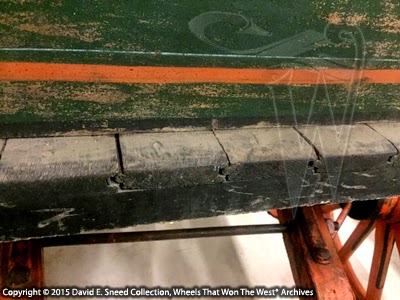I’ve shared a number of times that everypart of a period vehicle can hold clues related to its provenance. From age and use histories to maker labelsand design standards, paying attention to construction details can make all thedifference in what we know to be fact versus mere beliefs or speculation.
Some time ago, I had a discussion with afriend about the way floors were placed in early wagons. There were several techniques employed by periodbuilders of farm wagons. The most frequently seen style in surviving vehicles is tongue and groove. This type of interlocking construction works by fitting a grooved slot from one side of the board intoa protruded ridge from another board. Itoffers great strength and long-lasting sealing characteristics.
 |
| This image shows a wagon with the more commonly seen tongue and groove floor. |
A second method of placing boards in awagon floor is by simply butting the sides of the planks together. While simple to install, one of the primarychallenges for farmers was the difficulty in keeping the boards sufficiently tight in respect to each other. Over time, gaps between the boards wouldalmost certainly appear, allowing loose grain, seed, or other small items to fallthrough.
 |
| As can be seen in this image, laying boards side by side invariably left gaps making it tough to seal the floor of the box. |
A third approach to installing flooring fora box is similar to tongue and groove. Referredto as a shiplap floor, this design pulls the floor together by over andunderlapping adjoining boards. As withtongue and groove boards, shiplap construction allows for dimensional movementof the wood while also retaining longitudinal strength. While the design is effective at closinggaps, it may not seal quite as well as tongue and groove and sometimes can bemore susceptible to splintering and warping.
For some modern day collectors, the processof shiplapping a wagon floor may be tempting to view as a faster but lesseffective way of finishing a box. However,that opinion was clearly not shared by some well-known wagon makers. Over the last decade, I’ve encounteredseveral instances of original wagon boxes built in this way. In each circumstance, the wagon was known asa premium quality brand with an unquestioned national reputation.
 |
| Period wagons with original shiplap floors are not commonly found today. |
As we work to understand why certainbuilders did things in a particular way, it’s important to remember that major vehiclemanufacturers didn’t (and still don’t) typically rush into cheap alternatives inthe design of their products. Hard-earnedreputations for quality have too much to lose by ushering in unproven creations. While all builders looked for efficienciesthat made good business sense, there is a balance between saving time and moneywhile continuing to deliver excellent products.
Even with the use of shiplap floors by multipledominant manufacturers, the practice does not seem to have garnered wide-spread acceptance. Nonetheless, Irecently uncovered a catalog from yet another prominent brand touting thepreference of ship lap floors. The firmclaimed that these floors were “…much stronger than ‘tongued and grooved’...” It is known, however, that this same companydid eventually switch to the tongue and groove method. Why did they ultimately switch? Product availability, consumer preference, warping, splintering,or even sealing issues may have had something to do with it. We may never really know as I have also seenwarping and splintering in tongue and groove floors.
The true take-away from this informationgoes beyond which method proved to be best. It comes down to the need for enthusiasts to be acutely aware of differencesand prepared to understand what each area can tell us. Alertness to these details can beextraordinarily useful when determining timeframes of manufacture, rarity features, originality levels, andbrand identities.
In the end, the subject seems to sharesome similarities with early claims related to the upsetting (tightening) of tireson wooden wheels. As with the case of tongueand groove floors, some makers seem to have stuck predominantly with one methodof tightening tires while others experimented with two or more different directions. We’ll take a closer look at this topic in anupcoming blog as well.
Please Note: As with each of our blog writings, all imagery and text is copyrighted and may not be broadcast, published, rewritten, or redistributed without prior written permission from David E. Sneed, Wheels That Won The West® Archives.
Please Note: As with each of our blog writings, all imagery and text is copyrighted and may not be broadcast, published, rewritten, or redistributed without prior written permission from David E. Sneed, Wheels That Won The West® Archives.